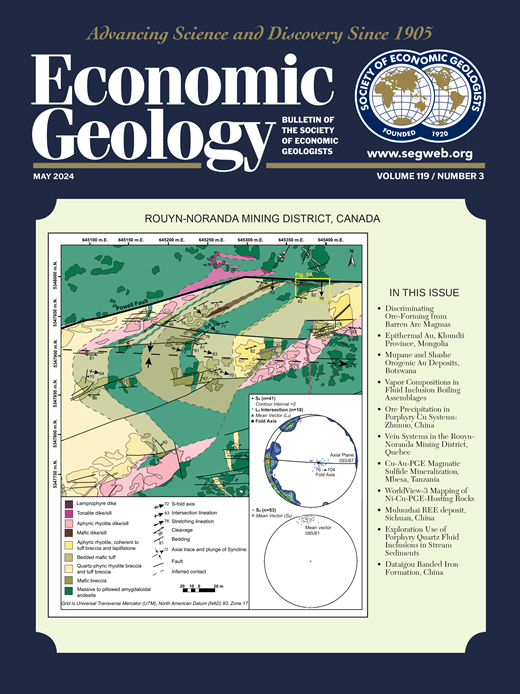北Bushveld杂岩Sandsloot深层平台的岩浆地层学:碳酸盐污染及其对ni - cu -铂族元素成矿的控制
IF 4.9
1区 地球科学
Q1 GEOCHEMISTRY & GEOPHYSICS
引用次数: 0
摘要
Platreef是南非Bushveld复合体的北部分支,被广泛认为是世界上最大的铂族元素(PGEs)资源之一,铂族元素是许多可持续技术发展所必需的关键金属。本文对沙司洛特露天矿已建成的沙司洛特露天矿进行了岩石学、整体地球化学和矿物化学研究,目的是建立岩浆地层学。这个新描述的层序由多达6个离散的辉长岩包体组成,在两个一致的单元中观察到显著的PGE和贱金属成矿作用:PGE礁和贱金属带。不同的CaO/Al2O3比值、不同的矿物和蚀变组合与不同的单元相关联,暗示了不同程度的碳酸盐污染和热液蚀变。已识别单元的母岩浆组成的变化是模棱两可的。PGE礁和富镍贱金属带与下垫Malmani亚群白云岩的污染密切相关(CaO/Al2O3比值≥2),尽管这不是矿化层所特有的,但最高的PGE等级都显示出这一特征。Sandsloot的深平台礁地层很难与Bushveld北部的深平台礁/临界带的其他剖面相关联,这可能是复杂和局部污染的作用,以及贫瘠和富pge岩浆的离散岩/指的侵位历史。尽管存在局部污染,但很明显,在北翼形成临界带序列的岩浆脉冲中,只有部分岩浆脉冲富含PGE。本文章由计算机程序翻译,如有差异,请以英文原文为准。
Magmatic Stratigraphy of the Deep Platreef at Sandsloot, Northern Bushveld Complex: Carbonate Contamination and Controls on Ni-Cu-Platinum Group Element Mineralization
The Platreef, northern limb of the Bushveld Complex, South Africa, is widely regarded as one of the world’s largest resources of platinum group elements (PGEs), critical metals that are essential for the growth of many sustainable technologies. In this study, the petrology, bulk geochemistry, and mineral chemistry of drill holes from the deep Platreef at Sandsloot, downdip from the established Sandsloot open pit, are examined, with the aim of establishing the magmatic stratigraphy. This newly described sequence is composed of up to six discrete pyroxenitic packages, with significant PGE and base metal mineralization observed in two consistent units: the PGE reef and the Base Metal zone. Varying CaO/Al2O3 ratios and mineral and alteration assemblages are associated with different units, alluding to varying degrees of carbonate contamination and hydrothermal alteration. Variations in parental magma compositions for the identified units are equivocal. The PGE reef and Ni-rich Base Metal zone are strongly associated with contamination from the underlying Malmani subgroup dolomites (indicated by CaO/Al2O3 ratios ≥ 2), and although this is not exclusive to the mineralized horizons, the highest PGE grades all show this signature. The stratigraphy of the deep Platreef at Sandsloot is difficult to correlate with other sections of deep Platreef/Critical zone in the northern Bushveld, which is likely a function of complex and localized contamination, and an emplacement history of discrete sills/fingers of barren and PGE-rich magmas. Notwithstanding the localized contamination, it is apparent that only some of the magmatic pulses that formed the Critical zone succession in the northern limb were PGE rich.
求助全文
通过发布文献求助,成功后即可免费获取论文全文。
去求助
来源期刊

Economic Geology
地学-地球化学与地球物理
CiteScore
10.00
自引率
6.90%
发文量
120
审稿时长
6 months
期刊介绍:
The journal, now published semi-quarterly, was first published in 1905 by the Economic Geology Publishing Company (PUBCO), a not-for-profit company established for the purpose of publishing a periodical devoted to economic geology. On the founding of SEG in 1920, a cooperative arrangement between PUBCO and SEG made the journal the official organ of the Society, and PUBCO agreed to carry the Society''s name on the front cover under the heading "Bulletin of the Society of Economic Geologists". PUBCO and SEG continued to operate as cooperating but separate entities until 2001, when the Board of Directors of PUBCO and the Council of SEG, by unanimous consent, approved a formal agreement of merger. The former activities of the PUBCO Board of Directors are now carried out by a Publications Board, a new self-governing unit within SEG.
 求助内容:
求助内容: 应助结果提醒方式:
应助结果提醒方式:


